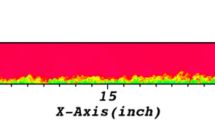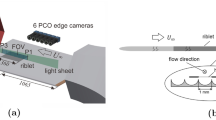Abstract
This work deals with the effect of the riblets on the coherent structures near the wall. The emphasis is put on the genesis of the quasi-streamwise vortices in the presence of the riblets. The quasi-streamwise vortices regenerate by the tilting of wall normal vorticity induced by prevailing structures. This requires a mechanism which leads to a temporal streamwise dependence near the elongated flow structures and to a subsequent formation of new wall normal vorticity. It is suggested here that the action of existing quasi-streamwise vortices on the sidewalls of wall normal vorticity may create a local, streamwise dependent spanwise velocity and therefore, a secondary wall normal vorticity field. A preliminary analysis of the set-up and the time and space development of this secondary three-dimensional flow associated with the regeneration mechanism, is given. An attempt is made, in order to explain the drag reduction performed by the riblets through an intermittent model, based on the protrusion height. Logical estimates of the amount of drag reduction are obtained. The differences between the mechanism suggested here and those based on forced control experiments are also discussed.
Similar content being viewed by others
References
Bacher E.V. and Smith, C.R., A combined visualization-anemometry study of the turbulent drag reducing mechanism of triangular micro-grove surface modifications. AIAA paper AIAA-85-0548 (1985).
Bechert, D. W. and Bartenwerfer, M., The viscous flow on surfaces with longitudinal ribs.J. Fluid Mech. 206 (1989) 105.
Bechert, D.W., Bartenwerfer, M. and Hoppe, G., Turbulent drag reduction by nonplanar surfaces — A survey on the research at TU/DLR Berlin. In: Gyr, A. (ed.),Proc. IUTAM Symp. Structure of Turbulence and Drag Reduction, Zurich, 25–28 July 1989. Berlin: Springer-Verlag (1990) pp. 525–543.
Benhalilou, M., Anselmet, F. and Fulachier L., Conditional Reynolds stress on a V-grooved surface.Phys. Fluids 6(6) (1994) 2101.
Bernard, P.-S., Thomas, J.-M. and Handler, R.-A., Vortex dynamics and the production of Reynolds stress.J. Fluid Mech. 253 (1993) 385.
Brooke, J.-W. and Hanratty, T.J., Origin of turbulence-producing eddies in a channel flow.Phys. Fluids A5(4) (1993) 1011.
Choi, K.-S., Near-wall structure of a turbulent boundary layer with riblets.J. Fluid Mech. 298 (1989) 417.
Choi, H., Moin, P. and Kim, J., Direct numerical simulation of turbulent flow over riblets. CTR Manuscript, Stanford University, Stanford, CA 94305-3030 (1992); also,J. Fluid Mech. 255 (1993) 503.
Chu, D.C. and Karniadakis, G.E., A direct numerical simulation of laminar and turbulent flow over riblet mounted surfaces.J. Fluid Mech. 250 (1993) 1.
Corcos, G.M. and Shermann, F.S., The mixing layer: Deterministic models of a turbulent flow. Part 1: Introduction and the two-dimensional flow.J. Fluid Mech. 139 (1984) 29.
Corcos, G.M. and Lin, S.J., The mixing layer: Deterministic models of a turbulent flow. Part 2: The origin of the three dimensional motion.J. Fluid Mech. 139 (1984) 67.
Doligalski, T.-L. and Walker, J.D.-A., The boundary layer induced by a convected two-dimensional vortex.J. Fluid Mech. 139 (1984) 1.
Gallagher, J.A. and Thomas, S.W., Turbulent boundary layer characteristics over streamwise grooves. AIAA Paper 84-2185 (1984).
Hamilton, J.M, Kim, J. and Waleffe, F., Regeneration of near-wall turbulence structures. In:Ninth Symp. on Turbulent Shear Flows, Kyoto, Japan, August 16–18 (1993) pp. 11-5-1/11-5-6.
Hooshmand, D., Youngs, R. and Wallace, J.M., An experimental study of changes in the structure of a turbulent boundary layer due to surface geometry changes. AIAA paper AIAA-83-0230 (1983).
Jiménez, J. and Moin, K., The minimal flow unit in near wall turbulence.J. Fluid Mech. 225 (1991) 213.
Jiménez, J., Kinematic alignment effects in turbulent flows.Phys. Fluids A4(4) (1992) 652.
Jiménez, J. and Orlandi, P., The rollup of a vortex layer near a wall.J. Fluid Mech. 248 (1993) 297.
Jiménez, J., On the structure and control of near wall turbulence.Phys. Fluids 6(2) (1994) 944.
Kawahara, G., Ayukawa, K. and Ochi, J., On the origin of streaky structures in wall-bounded turbulent flows. In: So, R.M.C, Speziale, C.G. and Launder, B.E. (eds),Near Wall Turbulent Flows. Amsterdam: Elsevier (1993) pp. 403–412.
Landahl, M.T., On sublayer streaks.J. Fluid Mech. 212 (1990) 593.
Lightill, M.J., In: Rosenhead, L. (ed.),Boundary Layer Theory in Laminar Boundary Layers. Oxford: Oxford University Press (1963) Ch. 11.
Luchini, P., Manzo, F. and Pozzi, A., Resistance of a grooved surface to parallel and cross-flow.J. Fluid Mech. 228 (1991) 87.
Luchik, T.S. and Tiederman, W.G., Timescale and structure of ejections and bursts in turbulent channel flows.J. Fluid Mech. 174 (1987) 529.
Lumley, J.L. and Kubo, I., Turbulent drag reduction by polymer additives: A survey. Sibley School of Mech. and Aero. Eng., Rep. FDA-84-07, Cornell University, Ithaca, NY (1984).
Naguib, A.M. and Wark, C.E., An investigation of wall-layer dynamics using a combined temporal filtering and correlation technique.J. Fluid Mech. 243 (1992) 541.
Orlandi, P. and Jiménez, J., A model for bursting of near wall vortical structures in boundary layers. In:Eight Symposium on Turbulent Shear Flows, Technical University of Munich, September 9–11. (1991) pp. 28-1-1/28-1-6.
Orlandi P. and Jiménez, J., On the generation of turbulent wall friction.Phys. Fluids 6(2) (1994) 634.
Phillips, W.R.C., Coherent structures and the generalized Lagrangian mean equation.Appl. Mech. Rev. 43(5) (1990) S227.
Phillips, W.R.C., On the etiology of shear layer vortices.Theor. Comput. Fluid Dynamics 2 (1991) 329.
Phillips, W.R.C, The genesis of streamwise vortices in a turbulent wall layer. In: Bonnet, J.P. and Glauser, M.N. (eds),Proc. of Iutam Symp. on Eddy Structure Identification in Free Turbulent Shear Flows. Dordrecht: Kluwer Academic Publishers (1993) pp. 35–41.
Robinson, S.K., Kline, S.J. and Spalart, P.R., Quasi-coherent structures in the turbulent boundary layer: Part II. Verification and new information from a numerically simulated flat plate layer. In:Zoran P. Zarić Memorial International Seminar on Near-Wall Turbulence, 16–20 May 1988, Dubrovnik, Yugoslavia (1988) pp. 3.1–3.38.
Robinson, S.K., The kinematics of turbulent boundary layer structure. NASA Technical Memorandum 103859 (1991).
Sendstad, O. and Moin, P., The near wall mechanics of three-dimensional turbulent boundary layers. Thermosciences Div. Rep. TF-57. Stanford University, Department of Mechanical Engineering (1992).
Sherman, F.-S.,Viscous Flow. New York: McGraw-Hill (1990).
Smith, C.R., Walker, J.D.A, Haidari, A.H. and Sobrun, U., On the dynamics of near wall turbulence.Philos. Trans. R. Soc. London Ser. A336 (1991) 131.
Swearingen, J.-D., Blackwelder, R.-F. and Spalart, P.-R., Inflectional instabilities in the wall region of bounded turbulent shear flows. Report CTR-S87 (1987) pp. 291–295.
Tang, Y.P. and Clark, D.G., On near-wall turbulence-generating events in a turbulent boundary layer on a riblet surface.Appl. Sci. Research 50 (1993) 215.
Tardu, S., Truong, T.V. and Tanguay, B., Bursting and structure of the turbulence in an internal flow manipulated by riblets.Appl. Sci. Res. 50 (1993) 189.
Tardu, S., Feng, M.Q. and Binder, G., Quantitative analysis of flow visualizations in an unsteady channel flow.Exp. in Fluids 17 (1994) 158.
Taylor, B.-K. and Smith, C.-R., Pressure gradient effect on the development of hairpin vortices in an initially laminar boundary layer. Report FM-15, Lehigh University, Department of Mechanical Engineering and Mechanics (1990).
Tullis, S. and Pollard, A., A numerical investigation of the turbulent flow over V and U groove riblets using a viscous wall region model. In: So, R.M.C., Speziale, C.G. and Launder, B.E. (eds.),Near-Wall Turbulent Flows. Amsterdam: Elsevier (1993) pp. 761–770.
Tullis, S. and Pollard, A., Modelling the time dependent flow over riblets in the viscous wall region.Appl. Sci. Res. 50 (1993) 299.
Vezin, P., Tardu, S. and Binder, G., Space time organization of near wall turbulence in an unsteady channel flow. In:International Symp. on Turbulence, Heat and Mass Transfer, Lisboa, August (1994).
Vukoslavcevic, P., Wallace, J.-M. and Balint, J.-L., On the mechanism of viscous drag reduction using streamwise aligned riblets: A review with some results. In:Proceedings on Turbulent Drag Reduction by Passive Means. London: Royal Aeronautical Society (1987) Vol. 290.
Vukoslavcevic, P., Wallace, J.-M. and Balint, J.-L., Viscous drag reduction using streamwise aligned riblets.AIAA. J. 30 (1992) 1119.
Walker, J.D.A., Wall layer eruptions in turbulent flows. In: Gyr, A. (ed.),2nd IUTAM Symp. on Structure of Turb. and Drag Reduction. Berlin: Springer-Verlag (1989) pp. 59–67; also NASA Tech. Memo. 102362, ICOMP-89-26.
Walsh, M.-J., Riblets. In: Bushnell, D.M. and Hefner, J. (eds),Viscous Drag Reduction in Boundary Layers. Progress in Astronautics and Aeronautics, Vol. 123 (1990).
Author information
Authors and Affiliations
Rights and permissions
About this article
Cite this article
Tardu, S.F. Coherent structures and riblets. Appl. Sci. Res. 54, 349–385 (1995). https://doi.org/10.1007/BF00863518
Received:
Accepted:
Issue Date:
DOI: https://doi.org/10.1007/BF00863518




